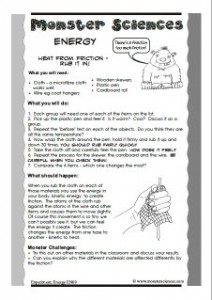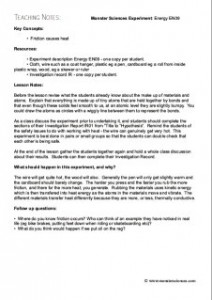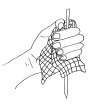It doesn’t take much to make some things hot with friction. In this energy experiment you will investigate different ways to create friction and feel the heat that results.
 |
 |
An energy science experiment about friction
What you will need:
• Cloth – a microfibre cloth works well
• Wire eg coat hangers
• Wooden skewers
• Plastic pen
• Cardboard roll
What you will do:
- Each group will need one of each of the items on the list.
- Pick up the plastic pen and feel it. Is it warm? Cool? Discuss it as a group.
- Repeat the “before” test on each of the objects. Do you think they are all the same temperature?
- Now wrap the cloth around the pen, hold it firmly and rub it up and down 30 times. You should rub fairly quickly
- Take the cloth off and carefully feel the pen. How does it feel?
- Repeat the process for the skewer, the cardboard and the wire. Be careful when you check them!
- Compare the 4 items – which one changes the most?
What should happen:
When you rub the cloth on each of those materials you use the energy in your body, kinetic energy, to create friction. The atoms of the cloth rub against the atoms in the wire and other items and causes them to move slightly. Of course this movement is so tiny we can’t possibly see it, but we can feel the energy it create. The friction changes the energy from one type to another – kinetic to heat.
Monster Challenges:
• Try this out on other materials in the classroom and discuss your results.
• Can you explain why the different materials are affected differently by the friction?
Teaching Notes: Monster Sciences Experiment: Energy EN09
Key Concepts:
• Friction causes heat
Resources:
• Experiment description Energy EN09 – one copy per student.
• Cloth, wire such as a coat hanger, plastic eg a pen, cardboard eg a roll from inside plastic wrap, wood, eg a skewer or ruler
• Investigation record IR – one copy per student.
Lesson Notes:
Before the lesson revise what the students already know about the make up of materials and atoms. Explain that everything is made up of tiny atoms that are held together by bonds and that even though these solids feel smooth to us, at an atomic level they are slightly bumpy. You could draw the atoms as circles with a wiggly line between them to represent the bonds.
As a class discuss the experiment prior to undertaking it, and students should complete the sections of their Investigation Report IR01 from ”Title to “Hypothesis”. Remind the students of the safety issues to do with working with heat – the wire can genuinely get very hot. This experiment is best done in pairs or small groups so that the students can double check that each other is being safe.
At the end of the lesson gather the students together again and hold a whole class discussion about their results. Students can then complete their Investigation Record.
What should happen in this experiment, and why?
The wire will get quite hot, the wood will also. Generally the pen will only get slightly warm and the cardboard should barely change. The harder you press and the faster you rub the more friction, and there for the more heat, you generate. Rubbing the materials uses kinetic energy which is then transfered into heat energy as the atoms in the materials move and vibrate. The different materials transfer heat differently because they are more, or less, thermally conductive.
Follow up questions:
• Where do you know friction occurs? Who can think of an example they have noticed in real life (eg bike brakes, putting feet down when riding or skateboarding etc)?
• What do you think would happen if we put oil on the rag?



